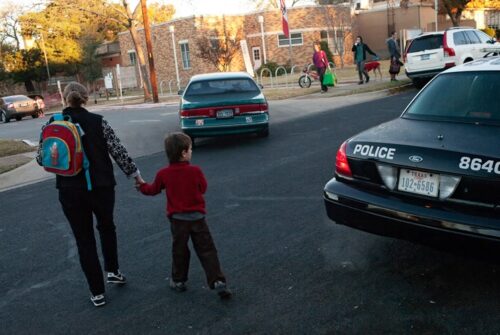11.10.23 – Texas Tribune – BY CAROLINE WILBURN AND MAIA PANDEY

Two new school safety funding measures passed out of committee Friday that could bring $1.3 billion more to Texas public schools.
The measures — House Bill 2 and House Joint Resolution 1 — were unanimously approved 14-0 by the House Select Committee on Educational Opportunity and Enrichment and now go before the House Calendars Committee, which is responsible for sending bills to the floor for full chamber votes.
In September, a new law requiring public school districts to develop active-shooter plans and mandating mental health training for certain employees went into effect. But since the Legislature passed these mandates in June, public school officials have complained they do not have enough money to comply with the law.
House Bill 2 would establish and fund two school safety grant programs that would help pay for security personnel, protective fencing, metal detectors and mental health prevention, among other school safety measures. To fund these grant programs, House Joint Resolution 1 would create a ballot measure that would go before voters next May.
HB 2’s first grant program, capped at $1.1 billion annually, would give each school additional money based on 1% of its current basic allotment, the amount of money the state gives a district for each student it’s educating. Districts with more than 2,000 students would receive no more than $200,000, which could be used for training personnel, maintaining security systems and providing mental health services.
The second grant program is capped at $250 million annually and would reimburse districts for approved school safety projects.
State Rep. Ken King, R-Canadian, who authored both of the new measures, said he worked with lawmakers throughout the summer to craft additional legislation boosting school safety funding.
“As much as I am really tired of more called sessions over and over, I am honored that I get another shot to put this before the [House] and before the Senate to ensure every kid that walks in a classroom is safe,” King said.
State Rep. Barbara Gervin-Hawkins, D-San Antonio, expressed concerns Friday that the legislation would only cover future projects and not reimburse schools for safety projects they had already undertaken.
“My concern is, for instance, ballistic shields were purchased for people, fencing was already done, technology was already done,” she said, “and schools are saying that they never had the amount to cover it.”
King said the bill would not retroactively cover past expenses but would cover the majority of future projects schools must take on to meet safety standards.
Advocates testifying to the committee Friday also stressed the importance of prioritizing mental health services and intervention when approaching school safety. Texas School Safety Center Board leaders, appointed by Gov. Greg Abbott, have said all age levels benefit from having a consistent program that monitors and supports their mental health.
Steven Aleman, policy specialist at Disability Rights Texas, said though the bill includes mental health intervention funding, it has been “patched on” to the existing school safety mandates. Ideally, mental health support would be the priority, particularly for special needs students, who are more likely to need special behavioral services, he said.
“We would like to see school safety addressed in terms of prevention,” Aleman added. “What can we do to support schools, school staff members, so that incidents don’t explode, so that kids don’t bring guns to school or use something as a weapon?”
Kristin Lewis, a fourth-grade teacher at Wood Elementary School in the Arlington Independent School District, said her school doesn’t have the resources to properly help students who have had disruptive, sometimes even dangerous outbursts, in her classroom .
“School safety is more than just hardening our schools. We need resources to assist with mental health,” Lewis said.
